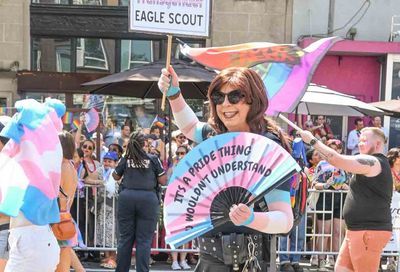All Fogged Up
A remake no better, no worse than the original tells the story of a ship full of angry ghost lepers bent on revenge
It’s not every day I ask for help from readers — but if any of you happened to catch the remake of The Fog last weekend, can you please drop me a line and tell me what in hell that ending meant? I already polled a few of the audience members at Sunday’s matinee and not a one of them could figure it out either.
From start to improbable finish, The Fog is no worse, and no better, than John Carpenter’s original 1980 sleeper. And by sleeper, I mean dull.
This Fog follows the same basic storyline with a few embellishments and a much prettier cast: The town of Antonio Island, Oregon, is celebrating the unveiling of a statue honoring four founding fathers. But eerie, awful things start happening when a massive, ominous fog bank envelopes the town, in the process killing as many of the townsfolk as it can.
 Get better visibility without a windshield: Welling |
Within the fog, you see, reside exceedingly angry ghosts, members of a leper colony royally screwed all those years ago by the founding fathers, who set their ship on fire, let them die a painful, horrible death, and then stole their treasure chests filled with gold, on which Antonio Island was built. Good for the town, bad for the lepers.
Now the leper specters enact revenge on everyone they can get their see-through mitts on. As with all horror films, the expendables go first — including a couple of partying girls. But what if you have an entire cast comprised of expendables? So many to kill, so little time — 100 minutes to be exact.
There’s an inconsistency to the way in which the ghosts kill — sometimes they burn you to a crisp, other times they hurl you through a window, and when they’re feeling really creative, they zing big shards of glass through your body. Obviously the lepers were not a decisive, ”let’s do it one way” group.
Cooper Lane’s screenplay is pretty much a carbon copy of the original by John Carpenter and the late Debra Hill, though he omits the original’s campfire ghost story, replacing it with a peek at some flashbacks to come.
Tom Welling, living proof that a boy with a body of steel need not know how to act so long as he can unbutton his shirt, plays Nick Castle, a role that went to the vastly less good-looking Tom Atkins in the 1980 version. Nick is the film’s hero — but his heroics amount to little more than driving around town screaming ”We have to leave this town NOW! NOW! NOW!” Some superman.
|
Selma Blair takes on the Adrienne Barbeau role as Stevie Wayne, the town DJ who operates her own station in a lighthouse and, in between songs, says things like ”There’s a fog bank rolling in. So close your windows.” She might have added ”Hermetically seal yourself in plastic wrap.” When Barbeau spoke into the radio microphone, she sounded sexy, sultry, like someone you’d want to tune into on a daily basis. When Blair, whose voice veers toward the sound you get when scratching a chalkboard, speaks into her mike, she sounds like she’s auditioning (badly) for a 1-800 porn line. The rest of the cast is unrecognizable and unexceptional, save Lost‘s Maggie Grace, as Nick’s girlfriend Elizabeth, who unravels the mystery behind the lepers and performs the movie’s ultimate act of heroism.
Elizabeth, suddenly returning home after a six-month visit to New York, has a bunny-on-fire relationship with Nick and a strained one with her mother, who tersely remarks upon seeing her daughter, ”Well, I wish you had called. I’m not running a hotel here.” Gee, what a nice mom — throw her to the lepers!
Director Rupert Wainwright generates a few tense moments late in the film — there’s a solid 20-minute stretch where things get a little scary. But it’s all framed by a molasses-drip buildup and an anti-climactic ending that, as I mentioned at the beginning of this column, leaves you shaking your head in bewilderment. You could almost say it leaves you in a fog.
Support Metro Weekly’s Journalism
These are challenging times for news organizations. And yet it’s crucial we stay active and provide vital resources and information to both our local readers and the world. So won’t you please take a moment and consider supporting Metro Weekly with a membership? For as little as $5 a month, you can help ensure Metro Weekly magazine and MetroWeekly.com remain free, viable resources as we provide the best, most diverse, culturally-resonant LGBTQ coverage in both the D.C. region and around the world. Memberships come with exclusive perks and discounts, your own personal digital delivery of each week’s magazine (and an archive), access to our Member's Lounge when it launches this fall, and exclusive members-only items like Metro Weekly Membership Mugs and Tote Bags! Check out all our membership levels here and please join us today!































